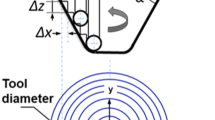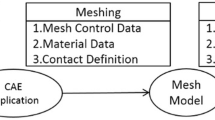Abstract
The simulation process is currently used in the design and dimensioning of mechanical parts. With the progress of computer materials, the finite elements method (FEM) becomes the most used approach in the simulation of mechanical behaviour. The simulation process needs multiple Design-FEM loops. In order to accelerate those analysis loops, an adaptation of computer aided design (CAD) model is necessary. The adaptation step consists in the simplification of the CAD model geometry by eliminating details (holes, chamfers, fillet, etc.) and faces. In this paper, a novel technique of simplification of the CAD geometry is developed. This technique is a hybrid method based on a combination of the elimination details and merging faces. The merging of faces is based on the energetic method. With this approach, the computing time is reduced by the elimination of geometric details which do not boundary conditions. An implementation of the proposed algorithm on the Open Cascade platform is also presented. The results of the developed method are compared with a previous publication. The reduction of the computing time and the amelioration of the result precision highlight the efficiency of the presented method.
Similar content being viewed by others
References
H. Zhu and C.H. Menq, B-rep model simplification by automatic fillet/round suppressing for efficient automatic feature recognition, Computer Aided Design, 34(2) (2002) 109–123.
S. Shahriari, S. Azadi and M. Moghaddam, An accurate and simple model for flexible satellites for three-dimensional studies, Journal of Mechanical Science and Technology, 24(6) (2010) 1391–1327.
M. Carnogurska, M. Prihoda and D. Popcakova, Modelling the flow conditions in the tunnel and its reduced model, Journal of Mechanical Science and Technology, 24(12) (2010) 2479–2486.
J. H. Song, S. Y. Hong, Y. Kang and H. G. Kil, Vibrational energy flow analysis of penetration beam-plate coupled structures, Journal of Mechanical Science and Technology, 25(3) (2011) 567–576.
S. K. Jung, S. Shin, R. S. Myong and T. H. Cho, An efficient CFD-based method for aircraft icing simulation using a reduced order model, Journal of Mechanical Science and Technology, 25(3) (2011) 703–711.
J. S. Choi, H. A. Lee, J. Y. Lee, G. J. Park, J. Park, C.H. Lim and K. J. Park, Structural optimization of an automobile transmission case to minimize radiation noise using the model reduction technique, Journal of Mechanical Science and Technology, 25(5) (2011) 1247–1255.
Z. Linghao, G. Dongming and G. Hang, A method to analyze the difference of 3-D CAD model files based on feature extraction, Journal of Mechanical Science and Technology, 25(4) (2011) 971–976.
W. Sun, Q. Ma and S. Chen, A Framework for automated finite element analysis with an ontology-based approach, Journal of Mechanical Science and Technology, 23 (2009) 3209–3220.
O. Hamri, J. C. Leon and F. Giannini, A new approach of interoperability between CAD and simulation models, TMCE, 25 (2005) 245–255.
S. H. A. Lee, CAD — CAE integration approach using feature-based multi resolution and multi-abstraction modelling techniques, Computer-Aided Design, 37 (2005) 941–955.
A. Thakur, A. G. Banerjee and S. K. Gupta, A survey of CAD model simplification techniques for physics-based simulation applications. Computer Aided Design, 41 (2009) 65–80.
P. Dabke, V. Prabhakar and S. Sheppard, Using features to support Finite Element idealization, International conference ASME, Minneapolis, 1 (1994) 183–193.
M. Belaziz, A. Bouras and J. M. Brun, Morphological analysis for product design. Computer Aided Design, 32(5) (2000) 377–388.
A. Sheffer, T. D. Blacker and M. Clustering, Automated detail suppression using virtual topoly. ASME, 26 (1997) 57–64.
C. G. Armstrong, R. J. Donaghy and S. J. Bridgett, Derivation of appropriate Idealisations in Finite Element Modelling. The Third International Conference on Computational Structures technology, Budapest, 3 (1996) 255–268.
R. Donaghy, W. McCune, S. Bridgett, C. Armstrong, D. Robinson and R. M. McKeag, Dimensional reduction of analysis models, Proceeding of 5th International Meshing Roundtable, Pittsburgh, PA (1996).
J. Y. Lee, J. H. Kim and H. S. A. Kim, Cellular topologybased approach to generating progressive solid models from feature-centric models, Computer Aided Design, 36(3) (2004) 217–229.
L. Fine, L. Remondini and J. C. Leon, Automated generation of FEA models through idealization operators. International Journal for Numerical Methods in Engineering, 49(1) (2000) 83–108.
A. V. Mobley, M. P. Carroll and S. A. Canann, An object oriented approach to geometry defeaturing for finite element meshing, Proceedings of International Meshing Roundtable. Dearborn, MI (1998).
H. Date, S. Kanai, T. Kisinami, I. Nishigaki and T. Dohi, High-quality and property controlled finite element mesh generation from triangular meshes using the multiresolution technique, Journal of Computing and Information Science in Engineering, 5(4) (2005) 266–276.
S. Kim, K. Lee, T. Hong, M. Kim, M. Jung and Y. Song, An integrated approach to realize multi-resolution of B-Rep model, Proceedings of the ACM Symposium on Solid and Physical Modeling, Cambridge, MA, (2005) 198–205.
G. Foucault, J. C. Cuillière, V. François and J. C. Léon, Adaptation of CAD model topology for finite element analysis, Computer Aided Design, 40(2) (2008) 176–196.
Y. Woo, Automatic simplification of solid models for engineering analysis independent of modeling sequences, Journal of Mechanical Science and Technology, 23 (2009) 1939–1948.
M. Hamdi, N. Aifaoui, B. Louhichi and A. Benamara, CAD/CAE interoperability, an automatic generation of Analysis Model based on idealization of CAD geometry, CFM2009, Marseille, France (2009).
M. Hamdi, N. Aifaoui, B. Louhichi and A. BenAmara, Idealization of CAD model for a simulation by a finite element method, European Journal of Computational Mechanics, 19(4) (2010) 419–439.
Author information
Authors and Affiliations
Corresponding author
Additional information
Recommended by Associate Editor Ki-Hoon Shin
Mounir Hamdi is a teacher of Mechanical Design at the Higher Institute of Technological Studies of Sousse, Tunisia. Hi is currently a Ph.D student in the National Engineering School of Monastir, University of Monastir. In 2000 he received his Mechanical engineering degree from National Engineering School of Monastir. In 2004 he received his Mechanical master degree from National Engineering School of Tunis. His main research interests include knowledge-based Computer Aided Design, interoperability and the application of geometric and solid model Simplification in CAD/CAE.
Nizar Aifaoui is an Associate Professor of Mechanical Engineering at Preparatory Institute for Engineers of Monastir in Tunisia. He obtained his Master Degree in Mechanical Engineering and Computer Science and Automation from Valenciennes University (France) in 1998 and Ph.D in Mechanical Engineering and Computer Science and Automation, respectively, from National Engineering School of Monastir (Tunisia) and Valenciennes University (France) in 2003. Dr. Aifaoui’s research areas include: CAD/CAM/CAE integration and Mechanical Design Methodology.
Abdelmajid BenAmara is a Professor of Mechanical Engineering at National Engineering School of Monastir in Tunisia. He obtained his Master Degree in Mechanical Engineering from National Engineering School of Tunis (Tunisia) in 1992 and Ph.D in Mechanical Engineering and Computer Science and Automation, respectively, from National Engineering School of Tunis (Tunisia) and Valenciennes University (France) in 1998. After an academic career, he integrated the Mechanical Engineering Department at the National Engineering School of Monastir in Tunisia. He contributes to the teaching of CAD, CAM, CAE and manufacturing technologies. Dr. BenAmara’s research areas include CAD/CAM/CAE integration, Manufacturing Technologies and Mechanical Design Methodology.
Rights and permissions
About this article
Cite this article
Mounir, H., Nizar, A. & Abdelmajid, B. CAD model simplification using a removing details and merging faces technique for a FEM simulation. J Mech Sci Technol 26, 3539–3548 (2012). https://doi.org/10.1007/s12206-012-0869-6
Received:
Revised:
Accepted:
Published:
Issue Date:
DOI: https://doi.org/10.1007/s12206-012-0869-6




